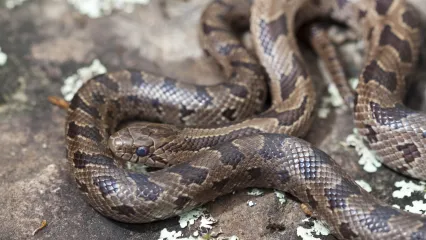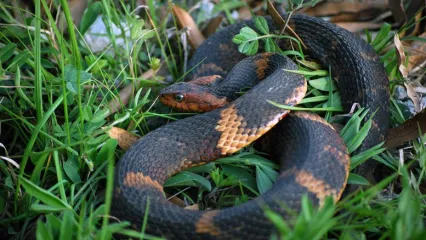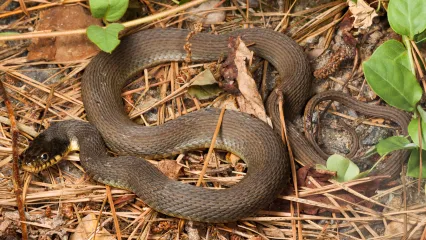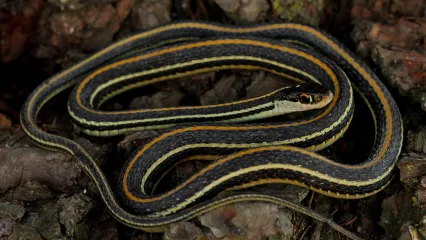
Description
Prairie kingsnakes are moderate-sized snakes with smooth, shiny scales, a background color of gray or light brown, and a series of 50 or more dark brown blotches across the midline of the back that extend about one-third down each side of the body. Occasionally, the dorsal blotches are split along the midline of the back such that a pair of blotches extends down the dorsal body surface. Below and between the dorsal blotches are smaller dark brown, nearly circular blotches starting on the second or third scale row and extending up to the fifth or sixth scale row. The dark brown blotches are outlined by a narrow black line. The belly is cream to tan in color and interrupted by faint rectangular or square dark markings that extend across several ventral scales. The anal plate is single. Prairie kingsnakes are most easily confused with Great Plains ratsnakes but can be distinguished as follows: the dorsal blotches on prairie kingsnakes are 4-6 scales long whereas blotches on Great Plains ratsnakes are 6 or more scales long; the ventral dark markings on prairie kingsnakes are faint and indistinct whereas ventral dark markings on Great Plains ratsnakes are very distinct; the anal plate on prairie kingsnakes is single whereas the anal plate on Great Plains ratsnakes is divided; the dorsal scales on prairie kingsnakes are smooth whereas they are slightly keeled on Great Plains ratsnakes, and the dark neck lines (if present) on prairie kingsnakes do not form a distinct spear point outline when they come together on top of the head whereas they do on Great Plains ratsnakes.
Size
Adults average 30-42 inches in total length. Hatchlings vary in size from about 9-12 inches in total length.
Habitat
Prairie kingsnakes occur in open prairie habitats with or without rocky outcrops and can also be found in riparian areas that dissect prairie. However, they are also common in agricultural areas, near buildings and other manmade structures, and in patches of forest. Because they are secretive, they are often overlooked. In North America, the west to east distribution of prairie kingsnakes extends from the Texas panhandle to central Tennessee and north to south from central Illinois to southern Texas. Another subspecies ranges east to the east coast.
Life Cycle
Their activity season extends from March or April through September and into October, depending on seasonal weather conditions. Mating occurs in early spring and females deposit eggs during May and June. Hatchlings appear in late August or September. Clutch size varies with female size with small females producing as few as nine eggs and large females producing as many as 21 eggs. Prairie kingsnakes feed primarily on small mammals, including mice, shrews, and woodrats. They also eat some lizards, particularly prairie racerunners. These snakes are harmless to humans.
How To Observe
Prairie kingsnakes are very difficult to observe in the field even though they are quite common. During spring and fall, they can be found on roads at dusk or at night where they stretch out to gain heat from the road surface. They can occasionally be found crawling around just before dark.
(This profile was created by Dr. Laurie Vitt as part of a partnership between the Wildlife Department and the Sam Noble Oklahoma Museum of Natural History. It was funded as part of a larger State Wildlife Grant to survey and inventory amphibians and reptiles of the Wildlife Management Areas of Oklahoma: T-35-P-1.)


